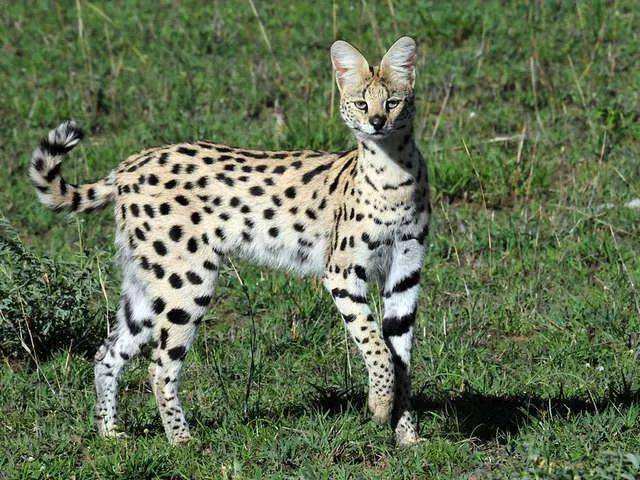Leptailurus serval
IUCN
LCBasic Information
Scientific classification
- name:Leptailurus serval
- Scientific Name:African Serval
- Outline:Carnivora
- Family:Carnivora Felidae Leptailurus
Vital signs
- length:59-92cm
- Weight:9-18kg
- lifetime:10-23 year
Feature
Once the world's largest luxury pet brand
Distribution and Habitat
Distributed in western, central and eastern Africa. Mainly inhabits savannahs, sometimes also in mountains, adapted to living in reeds at the edge of wetlands. Generally feeds on rodents, birds, fish, frogs and large insects such as locusts at dusk. Servals can help farmers catch locusts and rodents, and rarely hunt livestock. Because this species gathers near rivers, it is easily exposed and killed, and is also at risk of habitat loss.
Appearance
It is about 60 cm long from shoulder to tail, and its limbs and ears are the largest in proportion to its body. Its fur is yellow with black spots. The black spots or stripes on its fur vary in size and position from individual to individual. The ventral surface and the area near the mouth are white. There is a longitudinal stripe on the top of the head between the two ears, which extends all the way to the back and is divided into four sections. The stripe is scattered from the shoulder to the buttocks in a spot-like manner, and the vertical black spots merge with the tail ring. The tip of the tail is black. The back of the ear is black with a white stripe in the middle. In some areas where servals are distributed, individuals with black bodies also appear.
Solitary except during mating season. Most active from dusk to dawn the next day. Rest at noon or occasionally at night. Sometimes forage during the day, especially when it is cloudy and the weather is cold. Activity is reduced
Details
In some countries, especially the United States, servals are domesticated as pets. In Italy, the serval is the symbolic animal of the Tomasi family. The pronunciation of "serval" is: sǒu.

The serval is a species that looks like a leopard but is extremely "gentle" in heart. Its name comes from Spanish, which means "wolf like a deer". It is not difficult to understand from the meaning. From the appearance, the serval gives people a wild feeling, and because of this appearance, it has become a valuable breed. Although it is forbidden to be kept at home in China, it has become a pet of "rich people" abroad. From 2012 to 2017, it became the leader of luxury pets in the world. Many upper-class people spend a lot of money just to go out with it. Even Queen Elizabeth of the United Kingdom is fascinated by it. The serval raised at home is worth up to 60,000 yuan.
Regarding the issue of raising and selling servals, the staff of the Beijing Municipal Bureau of Landscape and Greening told the Beijing Youth Daily reporter that according to the Washington Convention list, servals are approved as national second-level protected animals, and institutions or individuals who raise them must hold the "National Key Protected Wildlife Domestication and Breeding License". The staff member introduced that domesticating servals requires certain knowledge of wild animals and a special domestication site, and the domestication site must also have safety protection measures such as isolation nets. The purpose of domestication is generally artificial breeding, scientific research, etc. "If you want to keep it as a pet at home, you will definitely not be approved for a license." The staff member said.
Servals can be bought and sold, but both buyers and sellers need to have a license, and the sale needs to be approved by the Forestry Bureau, registering the number of sales, the purpose of the sale, and the qualifications of both parties. If citizens find that someone is raising or selling servals without a license, they can report it to the supervision department of the Forestry Bureau.
Servals are wild cats in Africa, belonging to the species listed in Appendix 2 of the Red Book of Wild Species Protection, which is equivalent to a national second-level protected animal. The trend of private breeding of servals originated in the Middle East. In recent years, some Chinese people have chosen to keep servals as pets. Domestic cats have been domesticated by humans for 5,000 years, but even so, there is no guarantee that domestic cats will not attack humans. Servals are wild animals and medium-sized cats, which are more aggressive. In addition, when institutions such as zoos introduce foreign species, they will go through multiple quarantine inspection procedures, but the sources of servals sold by these private sellers are unclear and may carry epidemic diseases.
Servals are common in large national parks and important protected areas, and the status of populations outside protected areas is still unclear. The minimum density in the optimal habitat of Ngorongoro Crater is 0.42 per km² (Geertsema 1985), and in Luambe National Park in Zambia, the minimum density is 0.1 per km² (Thiel 2011). Due to the large-scale hunting in the farm areas of South Africa, the number of servals in that area is now very rare and no longer appears in human settlements.
Listed in Appendix II of the Convention on International Trade in Endangered Species of Wild Fauna and Flora (CITES).
Listed in the IUCN Red List of Threatened Species: Least Concern (LC), assessed in 2014.
Protect wild animals and eliminate game.
Maintaining ecological balance is everyone's responsibility!








